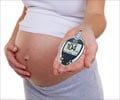A new biomarker that involves a single measurement of plasma glycated CD59 level could help to predict gestational diabetes, reveals study.

- Gestational diabetes is a type of diabetes that occurs in pregnant women usually at the 24th week of gestation.
- Glucose challenge test and oral glucose tolerance test are used for screening gestational diabetes.
- Scientists have found that a single measurement of plasma glycated CD59 (GCD59) level could be a new biomarker to diagnose gestational diabetes.
Assessing the Accuracy of Diabetes Biomarker
The accuracy of the diabetes biomarker GCD59 in predicting the results of the standard of care glucose challenge test which is used to screen for gestational diabetes was assessed.
The research team conducted a study on 1000 pregnant women who received a standard prenatal care at Brigham and Women’s Hospital. Out of the 1000 pregnant women, 500 women had a normal glucose challenge test (control), and the other 500 women required a subsequent oral glucose tolerance test.
The research findings revealed that
- When comparing to the control subjects, the plasma GCD59 value was around 8.5-fold higher than the patients who failed in the glucose challenge test.
- There was a 10-fold higher plasma GCD59 value in the subset of patients who met the criteria for diagnosing gestational diabetes in the oral glucose tolerance test.
Of the 58 large-for-gestational-age babies that were born to mothers who had failed the glucose tolerance test, 80% did not meet the oral glucose tolerance test criteria for gestational diabetes. However, they had a 7-fold higher plasma GCD59 level than control women with normal glucose challenge test.
There are no practical guidelines for women who fall between normal and abnormal glucose tolerance levels. Therefore the management is the same as that for women with normal glucose challenge test results.
Halperin, said, "These results suggest that a single measurement of plasma GCD59 during weeks 24-28 may also help stratify the risk for delivering larger infants among women with gestational glucose intolerance."
"Our studies opened an avenue for larger multicenter studies to further assess the clinical utility of plasma GCD59 for screening and diagnosis of gestational diabetes among the general population of the United States. If our results are confirmed, we're hopeful that the GCD59 test could be available in clinical practices within the next few years."
Gestational Diabetes
It is a type of diabetes which occurs during pregnancy. This could increase the risk of the mother to deliver a large-for-gestational-age baby.
Gestational diabetes could lead to pre-term birth, fetal injury, perinatal mortality and cesarean delivery. It may also be a risk factor for pre-eclampsia and gestational hypertension.
The risk of abnormal pregnancies could be overcome by following the recommended guidelines that involve screening all non-diabetic pregnant women.
Screening Gestational Diabetes
The screening process for gestational diabetes involves a two-step approach:
First step - Glucose Challenge Test
The test involves the administration of a sugary drink which is followed by a blood sugar measurement after an hour.
Pregnant women who fail this screening test are then sent to take the oral glucose tolerance test.
Second Step - Oral Glucose Tolerance Test
This test involves overnight fasting and then drinking a more concentrated sugar solution undergoing baseline and collecting blood hourly for three hours.
These tests are currently the only methods which are used to diagnose the pregnant women for gestational diabetes. However, they may be time-consuming and uncomfortable for mothers and have poor reported reproducibility.
References
- Gestational Diabetes - (http://www.diabetes.org/diabetes-basics/gestational/)
Source-Medindia















